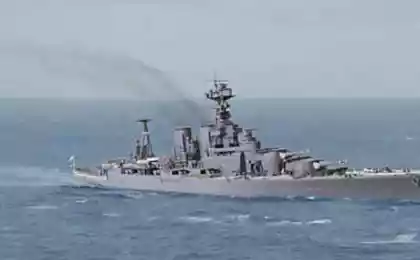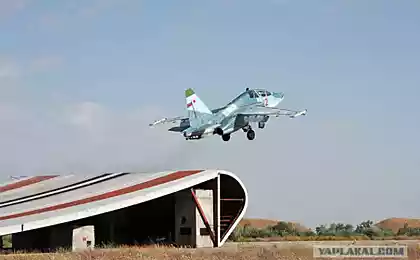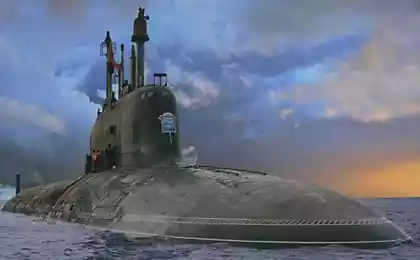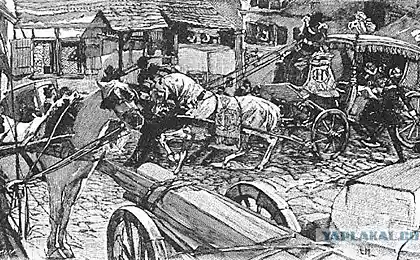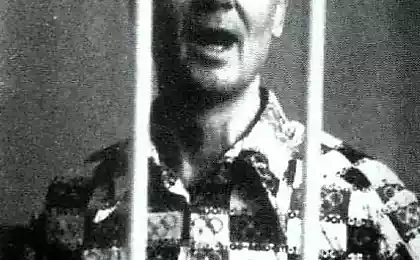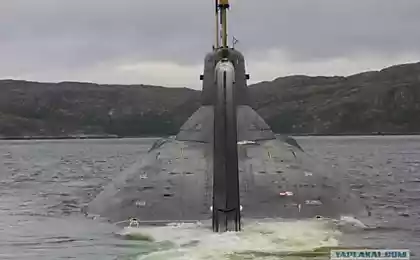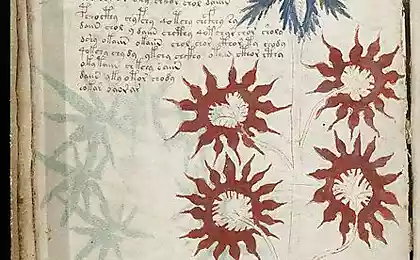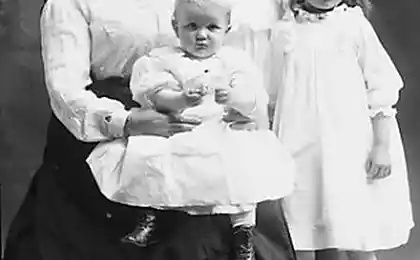714
The killer of aircraft carriers, 3 photos + text
The tragic story of "hundreds" T-4 ...
Throughout the post-war history of the USSR continually tried to find cheaper "antidote" to fight the kings of the oceans - the American nuclear aircraft carrier. Soviet "asymmetric" solution provided for the submarines to super high-speed missile torpedoes or cruise missiles, the nuclear-powered cruiser with hypersonic anti-ship missiles, the supersonic bomber with intelligent missiles.
By the end of 1950 it became clear that the Soviet Union can not adequately resist the US for no strategic aviation, nor in the Navy. Part of this could compensate for the deployment of intercontinental ballistic missiles, than, in fact, engaged in the Soviet Union. However, around the same time adopt the US began to arrive the first atomic submarine missile capable of hitting targets at ranges up to 2,200 km. Effectively deal with them the Soviet Union was not able to - space patrol submarines covered top American carriers. Punch defense aircraft carrier connections Soviet Navy could neither air, nor water, nor from under the water. The only way to destroy the US aircraft carrier was the use of it with a special ultra-fast missile warhead, in other words, the nuclear charge. Only here to get to the aircraft carrier ballistic missile could not - the goal did not stand still. The existing aircraft, ships and submarines were unable to approach that is not within range, but even find the target. The most realistic way to deal with aircraft carriers to the Soviet command saw the creation of the complex impact of aviation. He was supposed to consist of a high-speed aircraft, which could be found in a given area of the connection carrier force, and hypersonic missile, capable of speeds of 4-5 times the speed of sound, to break through the powerful air defense system aircraft carrier and strike its nuclear charge.
Maximum range destruction of marine anti-aircraft missiles that time amounted to 160 km, height - 30 km, and the rate of hitting targets - 775 m / s. This meant that the planes were available to strike at altitudes up to 25 km and speeds of up to 2650 km / h.
Neither was developed in the late 1950s in the Soviet strategic supersonic strike aircraft under these parameters do not fit. Project Tupolev 135 aircraft and the M-52 KB Myasishcheva were made mostly from aluminum alloy and are designed for maximum speeds of 2000-2500 km / h. However, in KB Myasishcheva develop other strategic bomber of the titanium alloy and alloy steel - M-56. The aircraft was able to withstand the kinetic heating of skin to 3000C and develop a speed of over 3000 km / h. However, it was originally designed as a bomber, designed for combat load of 9 tons, and had excessive take-off weight of about 230 tons.
Weaving
Hunter aircraft carrier was to have takeoff weight of about 100 tons, cruising speed of 3,000 km / h and a ceiling of 24 km. When approaching the target aircraft at that speed and altitude radars Americans were unable to bring him anti-aircraft missiles. Hit a promising attack aircraft in the rear hemisphere could neither fighter-interceptors or anti-aircraft missiles.
The new aircraft was to have a range of 6000-8000 km and carry at least two cruise missiles with a range of 400-600 km - it would allow him not to go into range air defense systems. The rocket itself was supposed to be a unique product - of a speed seven times greater than the speed of sound, to go off-line target and attack it.
The State Committee for Aviation Technology has offered to bid on such aircraft design bureau Tupolev, Sukhoi and Yakovlev - Mikoyan decided not to touch, as his office was overloaded with work on the future of the MiG-25. The implication was that the competition to win "Bomber" Tupolev, and "fighter" CB were brought visibility to competition. Especially as the Tupolev was the development of "project 135" - could only increase his speed to the required 3000 km / h. Contrary to expectations, "fighter" CB enthusiastically took up non-core topic. The Sukhoi project led Oleg Samoilovich. It was selected layout on a "duck" with canards and isolated pods, which were air intakes on the front edge of the wing. According to preliminary calculations, the take-off weight was 102 tons, hence the informal name of the "article 100" or simply "weaving».
The collapse of the patriarch
In July 1961, Scientific and Technical Council, which summed up the contest. The first have reported to Tupolev. "Project 135" has undergone a complete rout: the plane was too heavy (take-off weight of 190 tons) and has not been on high-speed performance - cruising speed of 2,500 km / h instead of the required 3,000 km / h. Tupolev protection system was built from the perspective of saving public funds: more profitable to build one type of universal, the more the plane is already developed - "article 135". He could solve both the strategic objectives, including nuclear strikes on the US and the task of further naval aviation.
The second of his "project Yak-35" reported Alexander Yakovlev. The plane looks like a US B-58 Hustler and myasischevsky M-52, had a takeoff weight of 84 tons, a cruising speed of 3300 km / h. At the end of Yakovlev lunged toward the patriarch bombers, "Andrei offers remain on the aluminum. This means regression in aeronautical engineering. We do not do anything new, but we have to move forward and develop new materials - titanium, steel. Tupolev just slows down the progress of aviation! "Tupolev jumped up and shouted:" The boy that you know to become? I steel aircraft engaged when you went under the table! You want to destroy the country? "Yakovlev said nothing.
Then the project aircraft T-4 ("article 100"), introduced Pavel Sukhoi. The machine, like the Yak-35, meet the requirements of the Air Force. Final conclusions decided to do after the next meeting of the Board in September 1961. Andrei Tupolev urgently commanded to prepare for the contest aircraft "125" is being developed to replace the Tu-22. But the "125-ka" was originally created for other specifications and speeds of up to 2,500 km / h. Time to remake it at 3000 km / h at the Tupolev was not. Therefore, the second scientific and technical council of "Project 125" was not exactly for the same reasons, which rejected the 135th. The winner was declared a project of Sukhoi. After a while, the Sukhoi Design Bureau came the chairman of the State Commission for Aviation Technology Piotr Dementyev and directly asked Pavel Osipovich abandon the project in favor of Tupolev and give him all the material: "This issue belongs to the Tupolev." "Excuse me, - said Sukhoi - but I won the competition and not Andrei. So I will not give up on the topic. " After a while he called Sukhoi Tupolev: "Pasha, you know how to make good fighters, bombers, but - no. This topic of mine, give up. " "It is because I can do a good fighter, I'll do a good bomber" - cut dry. Such stubbornness is not added to the constructor of friends in the industry.
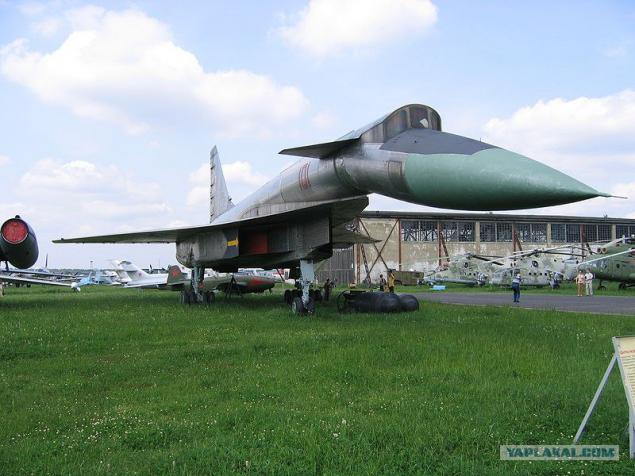
Engines
Such unique aircraft demanded at least the unique engine that could run on an unprecedented high temperatures, thin air and unconventional fuels. Initially, the T-4 involves the installation of three different types of engines, but eventually settled on one - RD36-41, the development of which led Rybinsk OKB-36 (now the "Saturn"). The engine was a distant relative of the powerful Soviet nonafterburning engine 1950 HP-7, which, in particular, equipped with myasischevskie bombers 3M. The engine aircraft was a single-shaft 11-stage compressor, afterburner and a two-stage turbine, air-cooled blades of the first stage, which increased the temperature of the gas before the turbine to 950K. To create RD36-41 took a total of about ten years, and based on it were created by other equally unique engines: RD36-51A stood on the passenger Tu-144, RD36-51V - by super-high scout M-17 "Stratosphere" RD36-35 used in the tests of the orbital plane "Spiral».
Rockets
No less important than the plane itself, was his main armament - hypersonic missile X-33, the development of which also began in the Sukhoi Design Bureau, but was later transferred to Dubninskaya branch of OKB-155 (now the "Raduga"). The rocket was supposed to go off-line to the goal of aeroballistic trajectory at an altitude of 30 km at a speed of 6, 5-7 times the speed of sound. After reaching the target area she found the order-carrier is calculated in the carrier, and it attacked him. It was at that time an unprecedented challenge - for its performance on the X-33 board sets its own radar and inertial navigation system, made up of the first digital computers were. According to the complexity of the control system did not yield a rocket airplane.
Upside Down
Many new and was in the cockpit of T-4. For the first time in the country it was designed to display the navigation and tactical situation where on the TV screen onboard radar data superimposed on an electronic image of microfilmed maps covering almost the entire surface of the globe.
In the design of the aircraft designers are constantly faced with a variety of previously never encountered problems. For example, the layout of the aircraft, won the competition, the chassis did not fit into its slot. To exit from the situation offers a rather exotic solutions - air intakes imposed on the "back", and after a predetermined course of the plane was supposed to roll down the cabin, and so of flying. When planting the bomber had to roll back to the original state.
Equally fantastic was another decision, which found expression in the plane. When the fuselage diameter of 2 m at a speed of 3000 km / h projecting lantern cockpit created huge resistance, and engineers decided to use the deflectable nose. When flying at an altitude of 22-24 km appear as such, no, around the black sky, so the nose of the raised and the flight takes place exclusively on instruments. When boarding, she deflected down and the pilot gets an excellent view through the open windshield. This idea was met with hostility by the military, and only enthusiasm and authority chief test pilot of Sukhoi Vladimir Ilyushin, son of the legendary aircraft designer, helped persuade the BBC. Ilyushin insisted also on the installation periscope for viewing ahead - in the event of a crash mechanism deflection bow. This solution has been used and subsequently civilian Tu-144 and Concorde.
By the way, the fairing brought many problems to developers, and its creation was one of the most difficult tasks. He had to be radio waves (radar antenna housed inside) and at the same time withstand the tremendous strength and temperature (up to 4000C) load. As a result, the material has been developed on the basis of hundreds of glass fillers, impregnated with a heat resistant binder. Himself fairing represented a five-layer structure in which the main load carrying an average layer thickness of 1, 5 mm. Outside cone covered thermal and weather-resistant silicone coating.
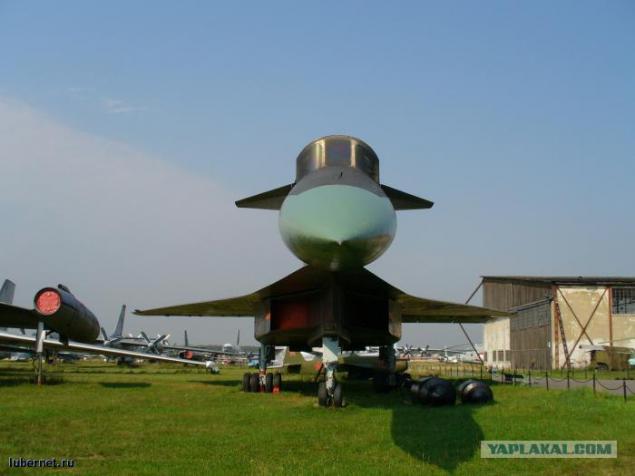
The flight
In the spring of 1972 the first flying prototype of T-4 ("article 101") was ready for flight tests, but because of the summer fires and peatland forests around Moscow drifted thick smoke and the visibility of the runway LII
them. Gromov was almost zero. Therefore, the first flight took place only 22 August 1972. Fly a plane Hero of the Soviet Union Vladimir Ilyushin and navigator Nikolay Alferov. The first stage was carried out nine operations, the first carried out with five uncropped chassis. The plane managed well, the pilot did not require special attention, the sound barrier is calm, and the time to overcome it marked only the instrument. Military, followed closely by test aircraft came away delighted and ordered in the coming five-year period (1975-1980 years) the first batch of 250 cars! For a machine of this class is a record edition.
The end of the "weave»
Tushino Machine Building Plant (TMP), built for Sukhoi experimental batch of seven aircraft could not produce them commercially, especially in the quantity ordered. The only plant that could master such an order - Kazan Aviation. In Kazan developed training equipment for the production of the latest bomber. This meant that the Tupolev lost its main production base. It could not allow neither the Tupolev nor his patron, Minister of Aviation Industry Peter Dementiev. Under the pretext release a modified version of the Tu-22 (and in fact, most of the new TU-22M) Dry "squeezed" from the Kazan plant.
Meanwhile, the second phase of testing. January 22, 1974 took place on the tenth flight of "hundreds" in which T-4 reached an altitude of 12 km and a speed of M = 1, 36. At this stage intended to bring the speed up to 3000 km / h (M = 2, 8) and start the test machine "102" with the standard set of radio equipment.
To build the first 50 aircraft Sukhoi offered at the Tushino engineering plant, assuming it completely restructure that was unlikely because of the lack of funds. But Dementiev deprived Dry and this small chance. At a regular meeting with the Minister of Defense, he persuaded him to close the T-4, turning on the TMP production for the newest wing of the Soviet MiG-23. Grechko has agreed, in March 1974, all work on the T-4 tests without explanation stopped.
Until his death 15 September 1975 Pavel Sukhoi received no satisfactory answer about the reasons for freezing the project T-4. Only
January 28, 1976 order was issued the Ministry of Aviation Industry under the number 38, which closes the work program "article 100". The same order Piotr Dementyev meant and the reason: "In order to concentrate efforts and resources on the creation of the Tu-160».
The aircraft "101" has been sent to the eternal parking in Monino Museum, where it remains to this day. In 1976, after the order, the Sukhoi Design Bureau has submitted an estimate for the costs of the aircraft T-4, which is priced at the time was a fantastic sum of 1, 3 billion rubles. The government uproar, but this latest surge of emotions "Sotka" to anything neither cited.
Unsinkable
None of the aircraft in the Soviet Union, either before or after the T-4 did not have such a number of original designs. Almost all the major components, systems and components of aircraft have been developed at the level of inventions - they were about 600. It was truly a giant leap forward in aircraft. Only here at the close of the theme aircraft was unable to solve its main problem - a breakthrough defense aircraft carrier order and the destruction of an aircraft carrier. As, however, we were unable to solve any Soviet submarines with super high-speed torpedoes "Squall" and cruise missiles or nuclear-powered cruiser.
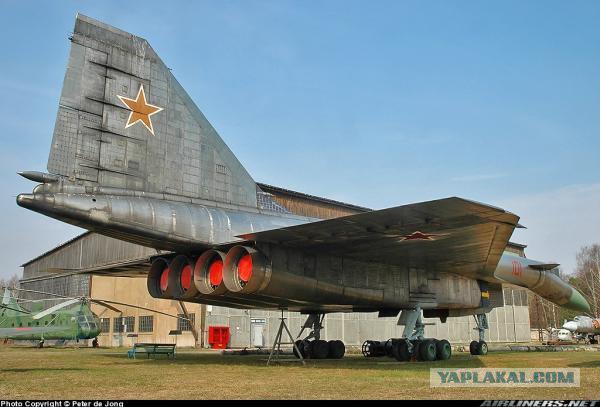
Source:
Throughout the post-war history of the USSR continually tried to find cheaper "antidote" to fight the kings of the oceans - the American nuclear aircraft carrier. Soviet "asymmetric" solution provided for the submarines to super high-speed missile torpedoes or cruise missiles, the nuclear-powered cruiser with hypersonic anti-ship missiles, the supersonic bomber with intelligent missiles.
By the end of 1950 it became clear that the Soviet Union can not adequately resist the US for no strategic aviation, nor in the Navy. Part of this could compensate for the deployment of intercontinental ballistic missiles, than, in fact, engaged in the Soviet Union. However, around the same time adopt the US began to arrive the first atomic submarine missile capable of hitting targets at ranges up to 2,200 km. Effectively deal with them the Soviet Union was not able to - space patrol submarines covered top American carriers. Punch defense aircraft carrier connections Soviet Navy could neither air, nor water, nor from under the water. The only way to destroy the US aircraft carrier was the use of it with a special ultra-fast missile warhead, in other words, the nuclear charge. Only here to get to the aircraft carrier ballistic missile could not - the goal did not stand still. The existing aircraft, ships and submarines were unable to approach that is not within range, but even find the target. The most realistic way to deal with aircraft carriers to the Soviet command saw the creation of the complex impact of aviation. He was supposed to consist of a high-speed aircraft, which could be found in a given area of the connection carrier force, and hypersonic missile, capable of speeds of 4-5 times the speed of sound, to break through the powerful air defense system aircraft carrier and strike its nuclear charge.
Maximum range destruction of marine anti-aircraft missiles that time amounted to 160 km, height - 30 km, and the rate of hitting targets - 775 m / s. This meant that the planes were available to strike at altitudes up to 25 km and speeds of up to 2650 km / h.
Neither was developed in the late 1950s in the Soviet strategic supersonic strike aircraft under these parameters do not fit. Project Tupolev 135 aircraft and the M-52 KB Myasishcheva were made mostly from aluminum alloy and are designed for maximum speeds of 2000-2500 km / h. However, in KB Myasishcheva develop other strategic bomber of the titanium alloy and alloy steel - M-56. The aircraft was able to withstand the kinetic heating of skin to 3000C and develop a speed of over 3000 km / h. However, it was originally designed as a bomber, designed for combat load of 9 tons, and had excessive take-off weight of about 230 tons.
Weaving
Hunter aircraft carrier was to have takeoff weight of about 100 tons, cruising speed of 3,000 km / h and a ceiling of 24 km. When approaching the target aircraft at that speed and altitude radars Americans were unable to bring him anti-aircraft missiles. Hit a promising attack aircraft in the rear hemisphere could neither fighter-interceptors or anti-aircraft missiles.
The new aircraft was to have a range of 6000-8000 km and carry at least two cruise missiles with a range of 400-600 km - it would allow him not to go into range air defense systems. The rocket itself was supposed to be a unique product - of a speed seven times greater than the speed of sound, to go off-line target and attack it.
The State Committee for Aviation Technology has offered to bid on such aircraft design bureau Tupolev, Sukhoi and Yakovlev - Mikoyan decided not to touch, as his office was overloaded with work on the future of the MiG-25. The implication was that the competition to win "Bomber" Tupolev, and "fighter" CB were brought visibility to competition. Especially as the Tupolev was the development of "project 135" - could only increase his speed to the required 3000 km / h. Contrary to expectations, "fighter" CB enthusiastically took up non-core topic. The Sukhoi project led Oleg Samoilovich. It was selected layout on a "duck" with canards and isolated pods, which were air intakes on the front edge of the wing. According to preliminary calculations, the take-off weight was 102 tons, hence the informal name of the "article 100" or simply "weaving».
The collapse of the patriarch
In July 1961, Scientific and Technical Council, which summed up the contest. The first have reported to Tupolev. "Project 135" has undergone a complete rout: the plane was too heavy (take-off weight of 190 tons) and has not been on high-speed performance - cruising speed of 2,500 km / h instead of the required 3,000 km / h. Tupolev protection system was built from the perspective of saving public funds: more profitable to build one type of universal, the more the plane is already developed - "article 135". He could solve both the strategic objectives, including nuclear strikes on the US and the task of further naval aviation.
The second of his "project Yak-35" reported Alexander Yakovlev. The plane looks like a US B-58 Hustler and myasischevsky M-52, had a takeoff weight of 84 tons, a cruising speed of 3300 km / h. At the end of Yakovlev lunged toward the patriarch bombers, "Andrei offers remain on the aluminum. This means regression in aeronautical engineering. We do not do anything new, but we have to move forward and develop new materials - titanium, steel. Tupolev just slows down the progress of aviation! "Tupolev jumped up and shouted:" The boy that you know to become? I steel aircraft engaged when you went under the table! You want to destroy the country? "Yakovlev said nothing.
Then the project aircraft T-4 ("article 100"), introduced Pavel Sukhoi. The machine, like the Yak-35, meet the requirements of the Air Force. Final conclusions decided to do after the next meeting of the Board in September 1961. Andrei Tupolev urgently commanded to prepare for the contest aircraft "125" is being developed to replace the Tu-22. But the "125-ka" was originally created for other specifications and speeds of up to 2,500 km / h. Time to remake it at 3000 km / h at the Tupolev was not. Therefore, the second scientific and technical council of "Project 125" was not exactly for the same reasons, which rejected the 135th. The winner was declared a project of Sukhoi. After a while, the Sukhoi Design Bureau came the chairman of the State Commission for Aviation Technology Piotr Dementyev and directly asked Pavel Osipovich abandon the project in favor of Tupolev and give him all the material: "This issue belongs to the Tupolev." "Excuse me, - said Sukhoi - but I won the competition and not Andrei. So I will not give up on the topic. " After a while he called Sukhoi Tupolev: "Pasha, you know how to make good fighters, bombers, but - no. This topic of mine, give up. " "It is because I can do a good fighter, I'll do a good bomber" - cut dry. Such stubbornness is not added to the constructor of friends in the industry.

Engines
Such unique aircraft demanded at least the unique engine that could run on an unprecedented high temperatures, thin air and unconventional fuels. Initially, the T-4 involves the installation of three different types of engines, but eventually settled on one - RD36-41, the development of which led Rybinsk OKB-36 (now the "Saturn"). The engine was a distant relative of the powerful Soviet nonafterburning engine 1950 HP-7, which, in particular, equipped with myasischevskie bombers 3M. The engine aircraft was a single-shaft 11-stage compressor, afterburner and a two-stage turbine, air-cooled blades of the first stage, which increased the temperature of the gas before the turbine to 950K. To create RD36-41 took a total of about ten years, and based on it were created by other equally unique engines: RD36-51A stood on the passenger Tu-144, RD36-51V - by super-high scout M-17 "Stratosphere" RD36-35 used in the tests of the orbital plane "Spiral».
Rockets
No less important than the plane itself, was his main armament - hypersonic missile X-33, the development of which also began in the Sukhoi Design Bureau, but was later transferred to Dubninskaya branch of OKB-155 (now the "Raduga"). The rocket was supposed to go off-line to the goal of aeroballistic trajectory at an altitude of 30 km at a speed of 6, 5-7 times the speed of sound. After reaching the target area she found the order-carrier is calculated in the carrier, and it attacked him. It was at that time an unprecedented challenge - for its performance on the X-33 board sets its own radar and inertial navigation system, made up of the first digital computers were. According to the complexity of the control system did not yield a rocket airplane.
Upside Down
Many new and was in the cockpit of T-4. For the first time in the country it was designed to display the navigation and tactical situation where on the TV screen onboard radar data superimposed on an electronic image of microfilmed maps covering almost the entire surface of the globe.
In the design of the aircraft designers are constantly faced with a variety of previously never encountered problems. For example, the layout of the aircraft, won the competition, the chassis did not fit into its slot. To exit from the situation offers a rather exotic solutions - air intakes imposed on the "back", and after a predetermined course of the plane was supposed to roll down the cabin, and so of flying. When planting the bomber had to roll back to the original state.
Equally fantastic was another decision, which found expression in the plane. When the fuselage diameter of 2 m at a speed of 3000 km / h projecting lantern cockpit created huge resistance, and engineers decided to use the deflectable nose. When flying at an altitude of 22-24 km appear as such, no, around the black sky, so the nose of the raised and the flight takes place exclusively on instruments. When boarding, she deflected down and the pilot gets an excellent view through the open windshield. This idea was met with hostility by the military, and only enthusiasm and authority chief test pilot of Sukhoi Vladimir Ilyushin, son of the legendary aircraft designer, helped persuade the BBC. Ilyushin insisted also on the installation periscope for viewing ahead - in the event of a crash mechanism deflection bow. This solution has been used and subsequently civilian Tu-144 and Concorde.
By the way, the fairing brought many problems to developers, and its creation was one of the most difficult tasks. He had to be radio waves (radar antenna housed inside) and at the same time withstand the tremendous strength and temperature (up to 4000C) load. As a result, the material has been developed on the basis of hundreds of glass fillers, impregnated with a heat resistant binder. Himself fairing represented a five-layer structure in which the main load carrying an average layer thickness of 1, 5 mm. Outside cone covered thermal and weather-resistant silicone coating.

The flight
In the spring of 1972 the first flying prototype of T-4 ("article 101") was ready for flight tests, but because of the summer fires and peatland forests around Moscow drifted thick smoke and the visibility of the runway LII
them. Gromov was almost zero. Therefore, the first flight took place only 22 August 1972. Fly a plane Hero of the Soviet Union Vladimir Ilyushin and navigator Nikolay Alferov. The first stage was carried out nine operations, the first carried out with five uncropped chassis. The plane managed well, the pilot did not require special attention, the sound barrier is calm, and the time to overcome it marked only the instrument. Military, followed closely by test aircraft came away delighted and ordered in the coming five-year period (1975-1980 years) the first batch of 250 cars! For a machine of this class is a record edition.
The end of the "weave»
Tushino Machine Building Plant (TMP), built for Sukhoi experimental batch of seven aircraft could not produce them commercially, especially in the quantity ordered. The only plant that could master such an order - Kazan Aviation. In Kazan developed training equipment for the production of the latest bomber. This meant that the Tupolev lost its main production base. It could not allow neither the Tupolev nor his patron, Minister of Aviation Industry Peter Dementiev. Under the pretext release a modified version of the Tu-22 (and in fact, most of the new TU-22M) Dry "squeezed" from the Kazan plant.
Meanwhile, the second phase of testing. January 22, 1974 took place on the tenth flight of "hundreds" in which T-4 reached an altitude of 12 km and a speed of M = 1, 36. At this stage intended to bring the speed up to 3000 km / h (M = 2, 8) and start the test machine "102" with the standard set of radio equipment.
To build the first 50 aircraft Sukhoi offered at the Tushino engineering plant, assuming it completely restructure that was unlikely because of the lack of funds. But Dementiev deprived Dry and this small chance. At a regular meeting with the Minister of Defense, he persuaded him to close the T-4, turning on the TMP production for the newest wing of the Soviet MiG-23. Grechko has agreed, in March 1974, all work on the T-4 tests without explanation stopped.
Until his death 15 September 1975 Pavel Sukhoi received no satisfactory answer about the reasons for freezing the project T-4. Only
January 28, 1976 order was issued the Ministry of Aviation Industry under the number 38, which closes the work program "article 100". The same order Piotr Dementyev meant and the reason: "In order to concentrate efforts and resources on the creation of the Tu-160».
The aircraft "101" has been sent to the eternal parking in Monino Museum, where it remains to this day. In 1976, after the order, the Sukhoi Design Bureau has submitted an estimate for the costs of the aircraft T-4, which is priced at the time was a fantastic sum of 1, 3 billion rubles. The government uproar, but this latest surge of emotions "Sotka" to anything neither cited.
Unsinkable
None of the aircraft in the Soviet Union, either before or after the T-4 did not have such a number of original designs. Almost all the major components, systems and components of aircraft have been developed at the level of inventions - they were about 600. It was truly a giant leap forward in aircraft. Only here at the close of the theme aircraft was unable to solve its main problem - a breakthrough defense aircraft carrier order and the destruction of an aircraft carrier. As, however, we were unable to solve any Soviet submarines with super high-speed torpedoes "Squall" and cruise missiles or nuclear-powered cruiser.

Source:
